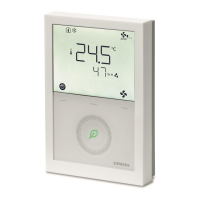Example of heating and cooling demand zones [➙ 123].
In S-Mode, the current state signals of the control outputs are available.
4.12.10 Fault and alarms function on KNX
A fault is sent on the bus in the event of a fault occur (for example, digital fault
input, Dewpoint, communication configuration, etc.).
An RDG2..KN room thermostat monitors the bus and sends its fault, if the fault has
the highest alarm priority. This ensures that the management station does not miss
any alarms.
The alarm with the highest priority is displayed first and sent over the bus if alarms
occur at the same time.
Fault transmission is different in LTE-Mode and S-Mode:
1)
Default alarm texts are stored in the thermostat’s non-volatile memory and can
be adjusted using the ACS commissioning tool.
2)
This error is not sent over the bus (because there is no bus, not enough bus
power supply, bus is overloaded or bus signal is distorted).

